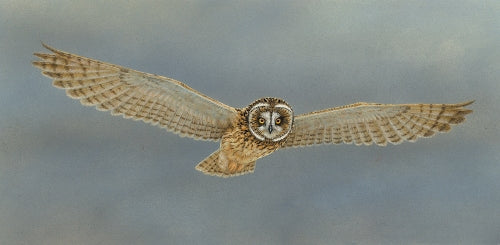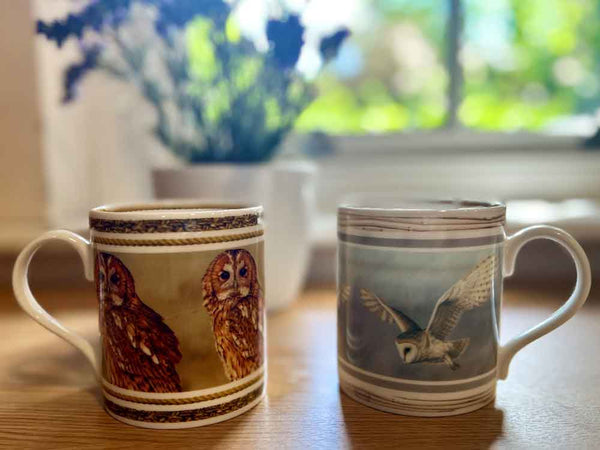I've just finished this painting of a short eared owl and it is now on show in my gallery in Thixendale, North Yorkshire.
.
Birds of prey have always
fascinated me, especially owls. I have studied barn owls, tawny and little owls
in great detail. But more elusive owls, such as short eared owls, were missing from my portfolio until this year.
The British Isles have
a resident population of short eared owls which mainly live on moorland. These
birds migrate to lower lying lands when cold weather sets in. But much of the Britain’s
winter population is made up of short eared owls that have migrated to the UK from Scandinavia, Iceland and even Russia. These birds are truly
nomadic in the sense that they will migrate over 1,000 miles in search of good
hunting grounds and to escape bad weather.
Living near the east coast,
we are perfectly placed to see the first migrant short eared owls as they
arrive in autumn. They favour large
areas of rough grass, estuaries and marshes where they are more likely to find
voles, their preferred prey.
You can tell what time
of day an owl hunts by the colour of its eyes. Short eared owls have a piercing
yellow eye, as do little owls and snowy owls. This indicates that they hunt
during the day. Whereas the almost black eyes of a tawny owl means it hunts
mainly at night. The painting below, which I also completed this year, shows just how bright their eyes are.
The fact that short
eared owls hunt during the day means that they are easy to watch, when you can
find them. The best time to see
them in winter is during the late afternoon and large numbers of owls can occur
in areas of good hunting.
I have seen them in
the valley below my gallery in Thixendale, but their hunting patterns can be
erratic and unreliable so when I learned of a popular short eared owl haunt
south of the Humber
River a year ago I took the
opportunity of a clear winter’s day and went to see them for myself.
I set out my chair and
tripod on the edge of a large patch of rough grass land shortly before lunch
and waited. Before long a charm of
goldfinches surrounded me, feeding on the thistles among the tussocks of grass,
as buzzards, kestrels, marsh and hen harriers flew above me.
Then just before 2pm, as if out of nowhere, the air
seemed to come alive with owls. I watched five short eared owls in the distance
as they took it in turns to attack the marsh harrier. The attack looked
almost synchronised as one by one they plummeted down like fighter planes mobbing
a target. They mobbed the
harrier, which had been sitting in a tree, until it gave up and flew away. Then
three more short eared owls joined them and all eight began quartering the
grassland to hunt on their long wings.
It was quite a
spectacle. I waited for one of the owls to come in range of my camera, but they
turned their attention to the buzzard which had been sitting on a fence post
for the past two hours minding its own business. They soon moved him on and resumed
skimming the long grass looking for voles.
It wasn’t long before
one of the short eared owls spotted a perch close to me. It landed on it for a
few minutes, shook its feathers – it was so close I could see the water
droplets as they spun off its streaked plumage – looked me in the eye, and then
it was off chasing another owl away. It was a really
special moment. Its eyes, which are set off by dark markings that look like
heavily applied mascara, are so piercing they seemed to see right through me.
There were so many
owls that it wasn’t long before another drama unfolded before me. An owl that I was
watching suddenly twisted in the air and then plummeted to the grass. I thought
that perhaps it had caught something. And so did the kestrel I had seen
earlier.
Within seconds it also
dived into exactly the same spot. I couldn’t see exactly what happened next but
there was clearly a tussle on the ground and the first to take flight was the
owl, clutching a vole in its talons.
It was closely
followed by the kestrel. Despite the fact that the kestrel was dwarfed by the
owl’s metre-long wingspan, the kestrel seemed determined to try and pinch the
owl’s prey.
The owl climbed higher
and higher into the sky with the kestrel in dogged pursuit. But as the owl
extended its lead, calling out angrily at the kestrel, the kestrel changed its
tactics. It moved away and then climbed higher than the owl. Then it turned and
stooped back down towards the owl. Swooping underneath it, the kestrel grabbed
the vole as it passed, leaving the owl in a bit of a spin.
The kestrel then
hovered down to the ground, transferring the vole from his talons to his beak
just before it landed, the sun just setting behind it.
I have seen kestrels pinch
meals off barn owls many times and the stealing has an official name, klepto-parasitism, but
I was surprised to see one try it with a larger owl.
It made for a
spectacular end to a great afternoon.






















